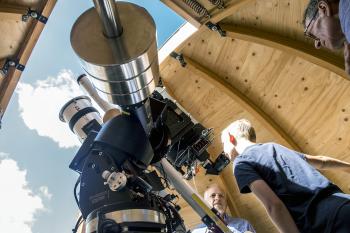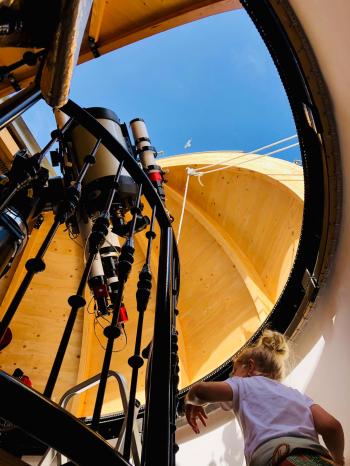Sun Watching DaySince 2019 the Royal Netherlands Association for Meteorology and Astronomy (KNVWS) organises an annual Sun Watching Day. Observatories all over the Netherlands, both private and public, open their doors to the public to allow them to have a look at the sun through various types of telescopes. Of course these telescopes are prepared for safe viewing or even dedicated solar telescopes like the Lunt LS80THA at InFINNity Deck. 2 June 2023 Figure 1: Nice blue skies with some 50% cumuli (photo by Richard Stekelenburg, Noordhollands Dagblad). On 2 June 2023 the fifth Sun Watching Day was organised by the KNVWS. Weather was good with only partial cloud-cover that mainly consisted of small-sized cumuli. A 4Bft westerly wind was beneficial to the observing as this meant the visitors never needed to wait too long before catching a glimpse of the Sun, while the clouds also helped to keep the seeing low. In total 28 visitors visited the observatory and adjacent garden in which additional set-up were available. Assisted by Caspar Tielemans, Rob Musquetier and Roman Korczyk it turned out to be another successful day (many thanks to these gentlemen!). The following telescopes were lined up:
3 July 2022On 3 July 2022 was the fourth national national Sun-Watching-Day. We had no fewer than 28 registrations. Assisted by Caspar Tielemans and thanks to the borrowing of an AZ-EQ6 with 100mm APO and a Herschel Wedge from Roman Korczyk, it turned out to be another successful day (many thanks to both gentlemen!). The following telescopes were lined up:
From midday onwards the skies started to clear and visitors could take the time to enjoy what there was to see. Seeing remained around 3 to 4 arcseconds throughout the day, so that even the C11 EdgeHD continued to provide splendid views until the end of the day. In white light only two small groups of sunspots were visible. Fortunately, there was more to experience in H-alpha with several big prominences. 4 July 2021 Figure 3: The 2021 Sun-watching-day with two set-ups in the garden, the observatory is just visible. On 4 July 2021 the predictions were equal to 2020, but once again weather changed positively during the morning. So instead of the forecast full cloud cover at 11:00am, skies remained 50% overcast up to about 3:00pm, allowing most of the 21 guests that day to see AR2835 and some prominences. After 3pm only AR2835 remained visible through the thin cloud cover which thickened over the next hour and a half. Only the last group, which arrived at 7pm, were unlucky to have full and thick cloud cover. A slide-show of some 100 images taken over the past year partially made up for that, while the visit to the closed observatory was much appreciated. During the morning and early afternoon astro-friends, Caspar, Rob and Roman assisted in receiving the groups. Roman had brought a Celestron azimuthal mount with a 100mm ED with Herschel-wedge and solar continuum filter, while Rob had brought his CGEM with 80mm APO and Daystar Quark. In the observatory four scopes were used to show the Sun: the SkyWatcher Esprit 150ED was used for imaging using a Baader ND5.0 foil filter and ZWO ASI1600MM Pro Cool camera, the Celestron C11 XLT EdgeHD was used visually with Baader ND5.0 foil filter and polarizing filters in the diagonal and eyepiece, the Lunt LS80THA was used visually native, and the GTT60 by projection. On 5 July 2020 conditions looked even worse than in 2019. The day before was fully overcast with plenty rain. In the morning of the Sun Watching Day itself it was still fully overcast and raining. At around 11:30am, half an hour after the first of 14 visitors arrived, the skies cleared enough to get a good glimpse of the sun. The rest of the day it stayed half overcast with plenty opportunity to have a look at the sun. This year I was assisted by astro-friends Roman and Rob. The former installed his SkyWatcher AZ-EQ6 mount with TS-Optics 100mm apochromate and white-light filter, the latter lend his Quark DayStar filter, which we mounted on a 130mm f/5 Bresser Messier Newton scope. Again the sun was not showing much exiting details, even though a few weeks earlier I had imaged a nice couple of protuberances on it. On 7 July 2019 we received 18 guests at the observatory. Weather conditions were marginal, the skies were heavily overcast, but despite that 16 of the 18 visitors were rewarded their trip with a view of the sun. The sun was around its minimum of its 11 year cycle, so not much to been seen sadly enough. I was assisted by astro-friends Roman and Caspar, the former informing visitors while I was with others in the observatory, the latter had brought a 80mm refractor with white-light filter, which was set-up in the garden next to the sundials. If you have any questions and/or remarks please let me know. |
InFINNity Deck... Astrophotography... Astro-Software... Astro Reach-out... Equipment... White papers...
Astro Education Topics Sun Watching Day


